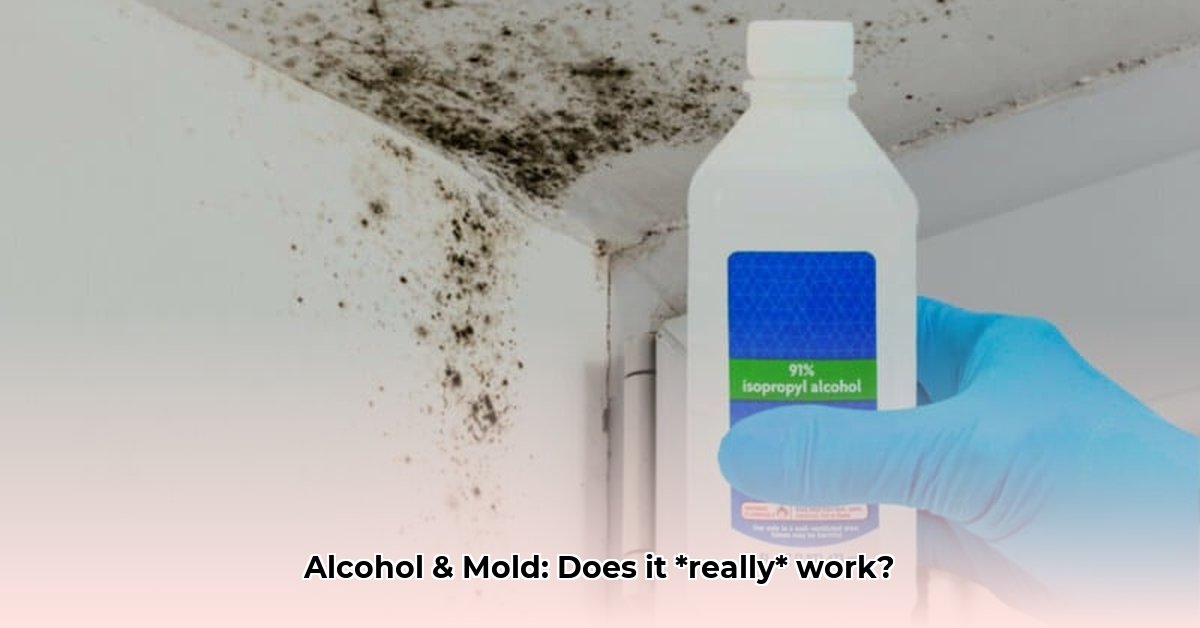Mold – that unwelcome fuzzy guest – often prompts the question: “Does alcohol kill mold?” The answer isn’t a simple yes or no. This comprehensive guide dives into the nuances of using alcohol for mold remediation, offering practical advice, safety precautions, and alternative solutions.
Alcohol and Mold: A Complex Relationship
Rubbing alcohol can be effective against certain types of mold, particularly on non-porous surfaces like glass, tile, and metal. It acts as a surface disinfectant, disrupting mold cell walls and killing the visible growth. However, it likely won’t eliminate all mold spores – those microscopic seeds capable of future growth. For tackling spores, hydrogen peroxide is generally more effective.
On porous materials like wood, drywall, or fabric, alcohol’s effectiveness is limited. It struggles to penetrate these surfaces, much like trying to clean a soaked sponge with a damp cloth. The mold often lies deep within the material, beyond alcohol’s reach. Professional mold remediation is usually necessary in these cases.
Choosing Your Weapon: Alcohol Types and Effectiveness
Not all alcohols are created equal in the battle against mold. Isopropyl alcohol (rubbing alcohol) is the go-to choice, ideally at a concentration of 70% or higher. Research suggests higher concentrations are more effective at disrupting mold cell walls. While 90-91% is ideal, 70% is readily available and often sufficient for surface mold. If you have 99% isopropyl alcohol, dilute it with distilled water.
Other alcohols like ethyl alcohol (found in beverages) can also be effective, but they are less practical and cost-effective for cleaning. Vodka or other low-concentration alcohols might work on superficial mold, but their potency is limited.
A Step-by-Step Guide to Using Alcohol for Mold Removal
Ready to tackle that mold? Follow these steps:
1. Safety First! Gear Up: Protect yourself with gloves, eye protection, and an N95 mask. Mold spores and alcohol fumes can be irritating and potentially harmful. Ensure good ventilation by opening windows and turning on fans.
2. Pre-Clean: Prepare the surface by cleaning it with soap and water to remove loose mold and debris. Allow it to dry completely.
3. Prepare Your Solution (If Necessary): Dilute 99% isopropyl alcohol with distilled water to achieve a concentration above 70%. Online dilution calculators can help determine the correct ratio.
4. Apply the Alcohol: Saturate the moldy area with the alcohol solution, ensuring thorough coverage.
5. Be Patient: Allow the alcohol to dwell for at least 15 minutes, giving it ample time to work. Reapply for stubborn mold.
6. Wipe and Dry: Wipe the area clean with a fresh cloth and ensure it dries completely to prevent mold regrowth.
When to Call in the Pros
Alcohol isn’t a miracle cure. For large infestations, mold on porous materials, or recurring issues, professional mold remediation is the safest and most effective solution. Professionals have the expertise and equipment to address the root cause of the problem.
Beyond Alcohol: Alternative Mold Removal Methods
Alcohol isn’t your only option. Other methods include:
| Method | Pros | Cons |
|---|---|---|
| Bleach | Strong disinfectant | Can damage surfaces, strong fumes, ineffective on porous surfaces |
| Vinegar | Natural, mild | Effectiveness debated, ineffective on porous surfaces |
| Commercial Removers | Specialized formulations | Can be expensive |
| Hydrogen Peroxide | Effective against spores, readily available | Can bleach some surfaces |
Each method has its pros and cons. Research is ongoing regarding the long-term effects and effectiveness of various mold removal methods.
Prevention: Your Best Defense Against Mold
Preventing mold is more effective than battling it. Control moisture levels by fixing leaks, using exhaust fans, and ensuring proper ventilation. Regular cleaning also helps prevent mold from taking hold. Some experts suggest using dehumidifiers to maintain low humidity levels.
Safety Precautions: Handling Alcohol Responsibly
While alcohol can be a useful tool, it’s crucial to handle it responsibly.
- Protective Gear: Always wear gloves, eye protection, and an N95 mask.
- Ventilation: Ensure adequate ventilation to prevent fume buildup.
- Flammability: Keep alcohol away from open flames and heat sources.
- Never Mix: Avoid mixing alcohol with other cleaning agents, especially bleach. This combination creates toxic chloroform gas.
The Bottom Line: Alcohol’s Role in Mold Removal
Does alcohol kill mold? Yes, but with caveats. It’s effective for surface mold on non-porous materials, serving as a useful tool for small, localized mold problems. However, it’s not a universal solution and should be used with caution and awareness of its limitations. Always prioritize safety, and don’t hesitate to consult professionals when needed. Ongoing research continues to shed light on mold and its remediation, so stay informed and adapt your approach as new information emerges.
- Pontoon Boat Seat Covers: The Ultimate Guide to Protection & Buying - April 17, 2025
- Covers for Pipework: A Complete Guide to Materials, Installation & More - April 17, 2025
- Dog Patio Door Inserts: A Comprehensive Guide to Choosing & Installing - April 17, 2025










